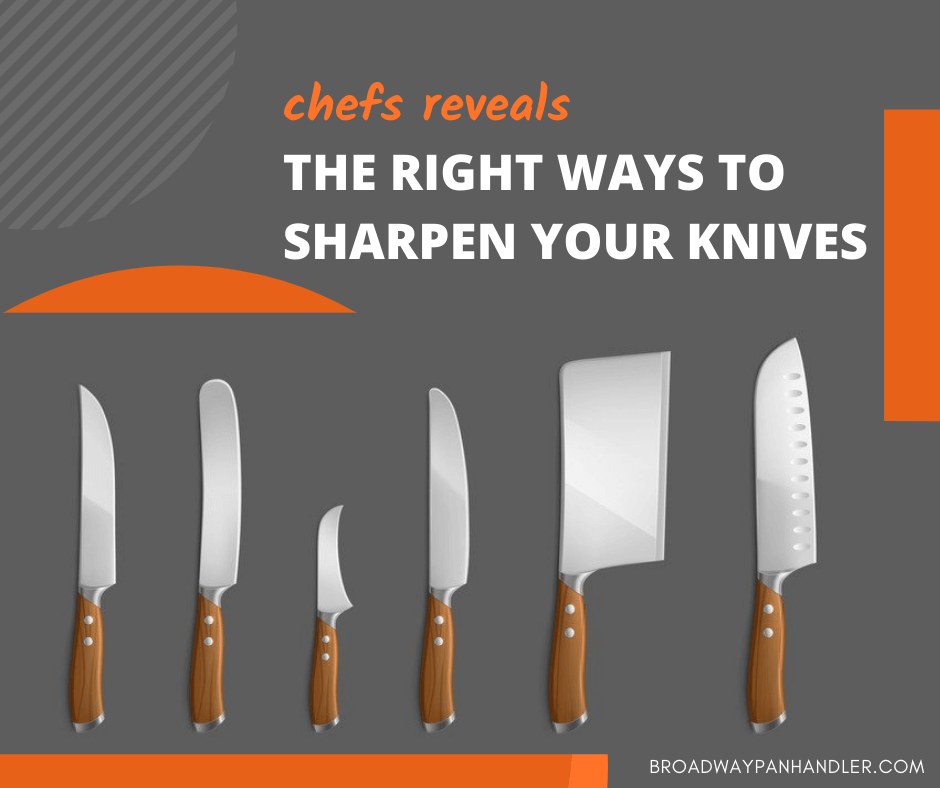You’ve probably heard someone say, “A good cooking knife is a sharp knife.” It may sound like a folk saying, but it’s true. Not only does a sharp knife make the cooking experience more enjoyable by slicing ingredients smoothly and efficiently, it’s also much safer than a dull blade.

Taking proper care of your knives will help prolong their lives and keep them nice and sharp for years. As home cooks, you don’t want a dull knife when it comes to carving the Thanksgiving turkey or Christmas ham. But don’t be deceived if your knife does get dull – you’d be amazed at how quickly a knife that can barely cut the skin of a tomato can slice right through the skin of your fingers!
3 Easy Ways and Methods to Properly Sharpen Your Kitchen Knife
Method 1: Use a fast and easy electric knife sharpener
The easiest way to sharpen your kitchen knives is to use an electric knife sharpener. Not only does this handy tool come with a manual that guides you step by step exactly how to use it while sharpening each knife, it also takes little to no skill to operate one.
To get the best result, look for an electronic sharpener that has three slots. Each slot is used for a different stage in the sharpening process – not for sharpening three blades at once! (There are also non-electric versions available that operate on the same principle.)
How to Use a Knife Sharpener
- Slot 1: This slot uses a hard material (usually diamond) to re-grind a dull knife that needs a lot of work.
- Slot 2: The second slot works to smooth out and polish your knife after the initial heavy grinding. If your knife isn’t too dull, skip the first step and start on the second slot for touch-ups.
- Slot 3: The last slot is typically made of steel-sharpening rods and is not electronic like the first two. This slot will correct any bends in the edge of your blade which occur through normal use. A bent blade can seem dull, but actually be sharp, so it never hurts to swipe your knife through Slot 3 more often than the others.
Be sure to pay attention while you are reviving your knife’s blade. If you let it sit in the grinder too long, the steel will wear down and weaken the blade. Also, older models of an electronic sharpener can be difficult to use if you are unsure of how to hold the blade at the appropriate angle. You don’t want to damage the investment you’ve made in quality knives.
Method 2: Sharpening the old-fashioned way using a Manual hand sharpener
If you’d rather take care of your kitchen knives by hand, you can get a manual sharpener to preserve your knives’ sharp edges.
To do this, you’ll need a whetstone (also called a sharpening stone). This is not the same as honing steel. Steel is what chefs use to straighten a bent blade. It’s the handheld version of the last slot on an electric sharpener.
Steel does not replace a sharpening stone, but should be used every few chopping sessions to keep your blade properly aligned.
Method 3: Sharpen Your Knife Using a Sharpening Stone
If you are slicing and dicing on a regular basis, you’ll want to sharpen your knives every few months – especially essential ones like your chef’s knife. While not as simple as an electric sharpener, many knife aficionados swear by the handheld ways of sharpening knives.
You may feel a little uncertain the first few times you sharpen your knives by hand, but before long you’ll feel like a kitchen warrior, preparing your blade for your next culinary conquest!
How to sharpen your kitchen knife using a stone
- Step 1: A standard stone needs to be presoaked in water to remove air bubbles. (High-quality stones usually don’t require any preparation.) After soaking, take your sharpening stone and place it on a non-slip cutting board, rough side facing up.
- Step 2: Hold your knife’s handle in one hand. With your other hand, hold the blade to the surface of the stone at about a 20-degree angle.
- Step 3: Using the hand on the blade as a guide, press down with medium pressure and slide the blade in a forward motion across the stone (about 10 times on each side of the blade).
- Step 4: After running both sides of the blade across the stone, set your knife aside and flip the sharpener over so the fine side is facing up. Repeat the same strokes you made while using the coarse side.
- Step 5: Once you have completed sharpening your knife, use the honing steel to make five strokes on each side of your blade at a 20-degree angle to straighten the edge. (See video below from Master Bladesmith Bob Kramer on how to use a steel.)
- Step 6: Carefully rinse the blade under water to make sure there are no steel particles or slivers left behind before using it to prepare food.